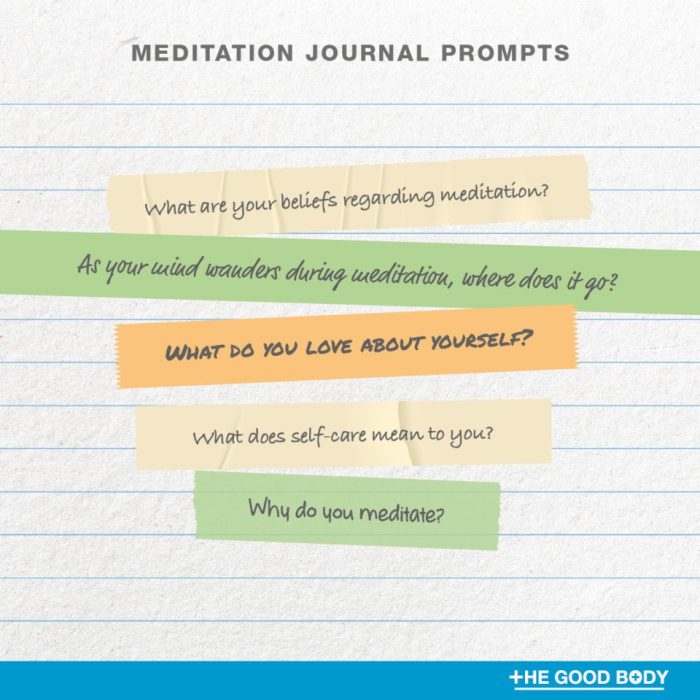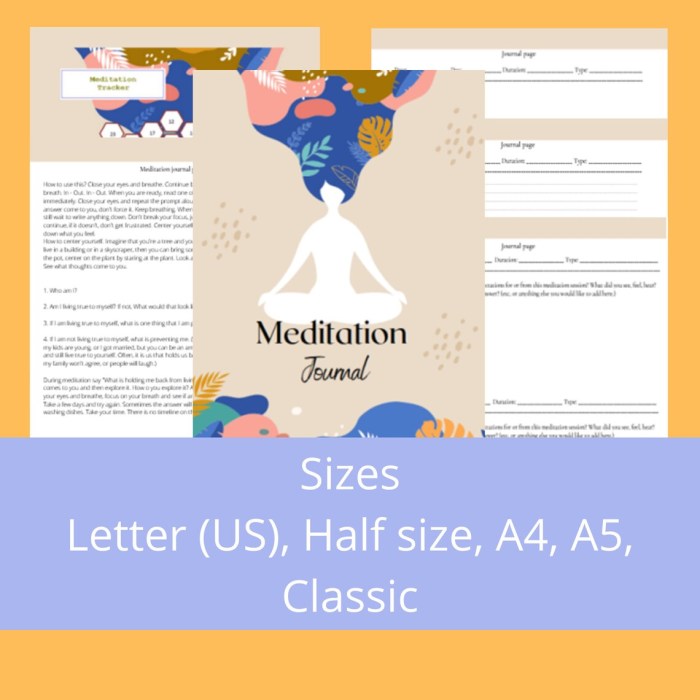Embark on the path of mindfulness with ‘4 Steps to Start a Meditation Journal’, where we explore the art of journaling for meditation practice in a comprehensive and insightful manner.
Discover the essential steps to kickstart your meditation journaling journey and cultivate a deeper sense of self-awareness and growth.
Introduction to Meditation Journal

Meditation journaling is a powerful practice that involves documenting your meditation experiences, thoughts, and reflections. It serves as a tool to track your progress, gain insight into your mind, and cultivate mindfulness in your daily life.
Benefits of Maintaining a Meditation Journal
- Enhances Self-Awareness: By writing down your thoughts and emotions before and after meditation sessions, you can gain a deeper understanding of your inner workings.
- Tracks Progress: Keeping a record of your meditation practices can help you see how far you have come in terms of focus, relaxation, and overall well-being.
- Promotes Reflection: Writing about your meditation experiences allows you to reflect on your journey, identify patterns, and learn from your insights.
- Boosts Accountability: A meditation journal holds you accountable for your practice, motivating you to stay consistent and dedicated.
Examples of What to Include in a Meditation Journal
- Start each entry with the date and time of your meditation session.
- Describe the environment you meditated in, including any sounds, smells, or sensations that stood out to you.
- Record your thoughts before and after meditation, noting any changes in your mental state.
- Write down any insights, realizations, or emotions that arose during your practice.
- Reflect on any challenges you faced during meditation and how you overcame them.
Setting Up Your Meditation Journal

To start your meditation journal, you will need to choose the right journal or notebook that suits your preferences and needs. Consider factors such as size, paper quality, and whether you prefer a digital or physical format.When selecting a journal for meditation practice, opt for one that feels comfortable to write in and is easy to carry around if you plan to journal on the go.
Choose a journal with good quality paper that can handle different types of writing instruments without bleed-through.
Different Formats for a Meditation Journal, 4 Steps to Start a Meditation Journal
- Digital: If you prefer a more tech-savvy approach, you can use a digital journaling app or software to keep track of your meditation practice. This format allows for easy organization and searchability of your entries.
- Physical: For those who enjoy the tactile experience of writing by hand, a physical journal or notebook can provide a more personal and intimate connection to your meditation practice.
Creating a Dedicated Space for Journaling
When setting up your meditation journal, consider creating a dedicated space where you can focus and feel inspired to write. This space should be quiet, free from distractions, and conducive to introspection.Set up a comfortable chair or cushion where you can sit and write comfortably. Add elements that promote relaxation and mindfulness, such as plants, candles, or calming music. Keep your journal and writing tools easily accessible in this space to encourage regular journaling practice.
Establishing a Routine

To make the most out of your meditation journal, it’s crucial to establish a routine that you can stick to. Consistency is key when it comes to journaling, as it helps you track your progress, identify patterns, and stay committed to your practice.
Importance of Consistency
Consistency in journaling allows you to reflect on your meditation experiences over time, providing valuable insights into your mental and emotional well-being. By journaling regularly, you can cultivate a sense of mindfulness and self-awareness that can enhance the benefits of your meditation practice.
- Set aside a specific time each day for journaling, whether it’s in the morning before you start your day or in the evening before bed.
- Choose a quiet and peaceful space where you can focus on your thoughts and feelings without distractions.
- Make journaling a non-negotiable part of your daily routine to ensure that you prioritize your mental health and well-being.
Integrating Journaling into Your Practice
Integrating journaling into your daily meditation practice can help you deepen your mindfulness and reflection. Here are some strategies to seamlessly incorporate journaling into your routine:
- Start each meditation session with a few moments of reflection on your journaling goals for the day.
- After your meditation session, take a few minutes to jot down any thoughts, emotions, or insights that arose during your practice.
- Use prompts or writing exercises to guide your journaling process and spark new insights and reflections.
Setting Achievable Goals
Setting achievable goals for journaling can help you stay motivated and focused on your meditation practice. Here’s how you can set realistic and attainable goals for journaling:
- Start by defining your purpose for journaling, whether it’s to track your progress, explore your emotions, or cultivate gratitude.
- Break down your journaling goals into smaller, manageable tasks that you can easily accomplish each day.
- Track your progress and celebrate small victories along the way to stay motivated and committed to your journaling routine.
Reflecting and Growing: 4 Steps To Start A Meditation Journal

After consistently journaling your meditation practice, it’s essential to reflect on your entries to track your progress and personal growth. This reflection will help you adjust your journaling practice as needed and continue evolving in your meditation journey.
Reviewing Your Journal Entries
- Set aside time regularly to review your journal entries, whether it’s weekly or monthly, to see patterns or changes in your meditation practice.
- Look for any shifts in your mindset, emotions, or physical sensations that may have occurred during your meditation sessions.
- Reflect on any challenges you faced and how you overcame them, as well as moments of clarity or breakthroughs you experienced.
Tracking Progress and Personal Growth
- Use your journal to track the length of your meditation sessions, the techniques you used, and any insights or realizations you had during each session.
- Monitor how your focus, awareness, and overall well-being improve over time through your meditation practice.
- Celebrate small victories and milestones in your meditation journey to stay motivated and encouraged to continue.
Adjusting Your Journaling Practice
- As you evolve in your meditation practice, consider adjusting the format or content of your journal entries to better suit your changing needs and goals.
- Experiment with different journaling techniques, such as gratitude journaling, intention setting, or mindfulness prompts, to deepen your self-reflection and growth.
- Be open to trying new approaches or tools, such as meditation apps or guided journals, to enhance your meditation experience and journaling practice.
Outcome Summary

In conclusion, ‘4 Steps to Start a Meditation Journal’ equips you with the tools and guidance needed to enhance your meditation practice and embrace personal transformation through reflective journaling.